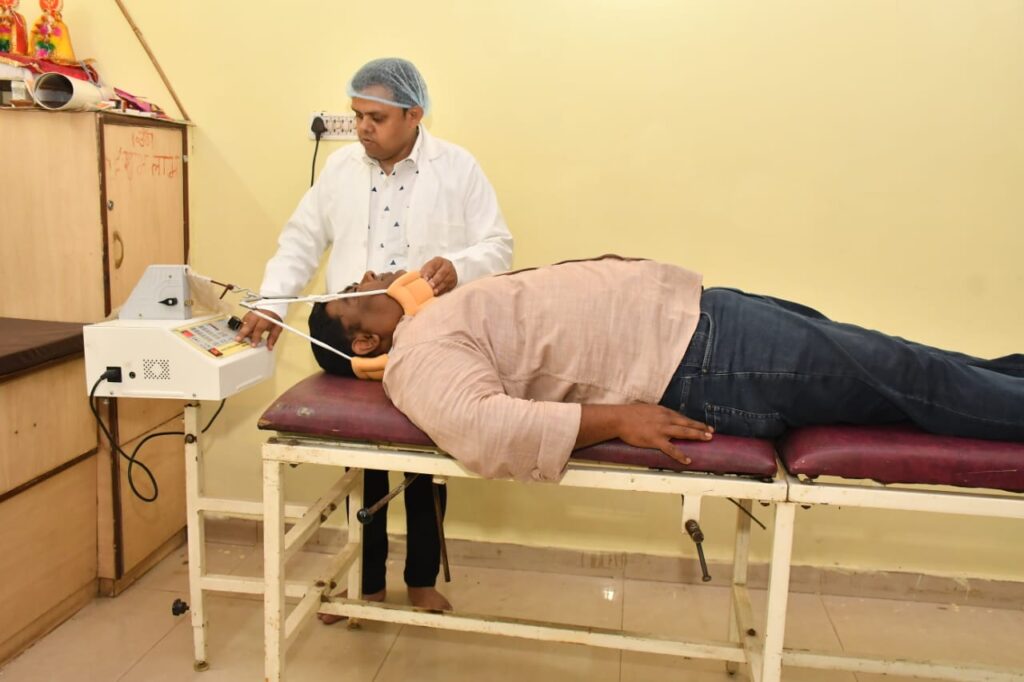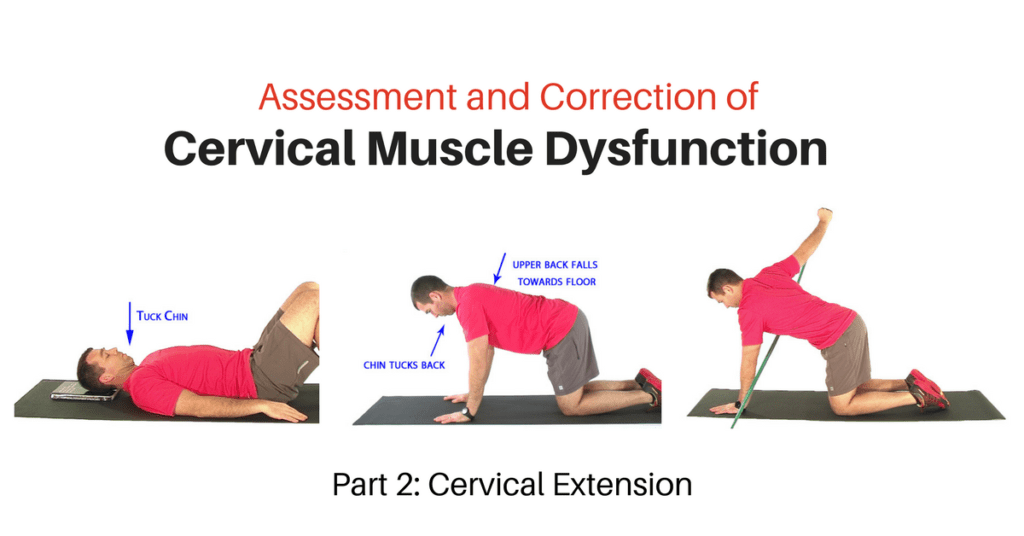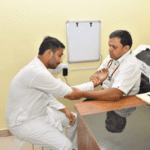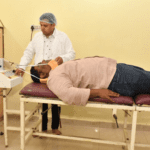Ease Neck Pain with Cervical Radiculopathy Exercises

Easing Neck Pain: The Role of Cervical Radiculopathy Exercises

Cervical radiculopathy, a condition where nerves in the neck are compressed or irritated, can cause significant discomfort. This pain may spread from the neck down the arm and even to the fingers, often due to spinal wear or acute injury. However, there’s a beacon of hope for those suffering from this condition: cervical radiculopathy exercises.
These exercises are a non-invasive solution that can lead to substantial pain relief. By regularly practicing specific movements, you can alleviate the pressure on the nerves, thereby reducing pain and improving your overall mobility. Engaging in cervical radiculopathy exercises not only helps in managing the pain but also contributes to a better quality of life.
Incorporating cervical radiculopathy exercises into your daily routine can be a game-changer. With their ability to soothe discomfort and enhance neck function, these exercises are a vital tool in the journey toward recovery. Remember, a consistent and gentle approach is key to maximizing the benefits of cervical radiculopathy exercises.
Also, read Regain Shoulder Mobility with Simple Frozen Shoulder Exercises
Physiotherapy: A Key to Cervical Radiculopathy Relief

Physiotherapy stands as a cornerstone in treating cervical radiculopathy. It employs various techniques, with a strong emphasis on cervical radiculopathy exercises, tailored to relieve the pain. Such exercises are designed to enhance the flexibility and strength of neck and spine muscles, which is crucial in easing nerve pressure.
Cervical radiculopathy exercises are a primary tool that physiotherapists use to help patients regain their range of motion. These exercises, when done regularly and correctly, can be incredibly effective in not just managing pain, but also in preventing future discomfort.
The role of physiotherapy is significant because it offers a proactive approach to healing. Patients empowered with cervical radiculopathy exercises can actively participate in their recovery process. The gradual strengthening and stretching bring long-term benefits, making physiotherapy a vital component of managing cervical radiculopathy. With dedication to these exercises, patients often experience a marked improvement in their condition.
Download Cervical Radiculopathy Exercises PDF by Dr sharad Gupta
Also, read Dr. Sharad Gupta: The Best Physiotherapy in Kanpur
Exercise #1 – Neck Retraction Exercise
Relief Through Neck Retractions: Simple Cervical Radiculopathy Exercises

Neck retractions are a key exercise in managing cervical radiculopathy. ThRadiculopathyey is simple and can be done anywhere. If you’re feeling nerve pressure, these exercises could help.
Here’s how to do a neck retraction: Sit or stand up straight. Gently pull your head back while your eyes stay focused ahead. It’s like you’re trying to make a double chin. Hold this for about 5 seconds. Then, ease back to the start. Do this 10 times.
These movements work the neck muscles. They’re not just for pain relief; they also strengthen the muscles. This means better support for your neck. Doing neck retractions regularly is a great way to keep your neck muscles strong and flexible, which is essential for anyone dealing with cervical radiculopathy. Make these exercises a part of your routine to help keep your neck happy and healthy.
Exercise #2: Shoulder Blade Squeeze
Strengthen Your Neck with Shoulder Blade Squeezes

Shoulder blade squeezes are an excellent exercise for anyone suffering from cervical radiculopathy. They’re easy to do and offer great benefits for both your posture and the muscles around your neck. Here’s how to do them:
Stand or sit upright, and let your arms hang by your sides. Now, imagine you’re trying to hold a pencil between your shoulder blades. Squeeze them together tightly, hold this squeeze for a few seconds, and then gently release. Repeat this movement about 10 times.
Performing this cervical radiculopathy exercise regularly can strengthen the muscles that keep your neck supported. This not only helps in reducing current pain but also in preventing future discomfort. Shoulder blade squeezes are a simple, yet powerful exercise to include in your cervical radiculopathy exercise routine. They are small movements that can make a big difference in how your neck feels.
Exercise #3: Scalene Stretch
Ease Neck Tension with Scalene Stretches

Scalene stretches are a key part of cervical radiculopathy exercises, aimed at easing neck tension. If your neck feels tight, this exercise might help. Here’s what to do:
Sit tall and straight. Now, gently tilt your head to the side, bringing your ear towards your shoulder. For a deeper stretch in the scalene muscles, use your hand to softly pull your head a bit further down. Keep this position for 15 to 30 seconds. Then, switch and do the same on the other side.
Adding this stretch to your cervical radiculopathy exercises can help reduce the tightness that often leads to nerve compression in your neck. Doing this regularly can make a noticeable difference in your comfort level. Scalene stretches are a simple and effective way to help manage cervical radiculopathy.
Exercise #3– Levator Scapulae Stretches
Soothe Your Neck with Levator Scapulae Stretches

When it comes to cervical radiculopathy exercises, the Levator Scapulae Stretch is a must-do. It’s designed to ease the muscles at your neck’s back and shoulders. Here’s a simple guide:
Place a hand on the back of your head. Now, gently tilt your head forward and across, like you’re aiming to peek into your armpit. Use your hand to apply a gentle pull, increasing the stretch. Hold this for 15 to 30 seconds. Remember to breathe. Then, do the same on the other side.
Regularly including this stretch in your cervical radiculopathy exercises can help relieve the tension that builds up in your neck and shoulders. It’s a straightforward stretch that can offer a lot of relief and is a great addition to your daily routine to help manage neck discomfort.
Exercise #5: Cervical Extension
Cervical Extension: A Simple Exercise for Neck Relief

Cervical extensions are a beneficial part of cervical radiculopathy exercises. They can help to relieve stiffness and improve flexibility in your neck. Here’s a quick guide to doing them right:
Start by sitting or standing in a comfortable position. Gently tilt your head back, looking up at the ceiling. This movement extends your neck. Hold this position for a couple of seconds, then slowly return to the starting position. Aim to do this movement about 10 times.
Incorporating cervical extensions into your routine of cervical radiculopathy exercises can make a big difference. They’re simple, can be done almost anywhere, and are especially helpful for those who spend a lot of time looking down at screens or books. Regular practice can lead to better neck mobility and decreased discomfort.
Also, read Physiotherapy Exercises for Lower Back Pain | Dr Sharad Gupta
Daily Routine: Integrating Cervical Radiculopathy Exercises

Making cervical radiculopathy exercises a part of your daily routine is crucial for managing neck pain. Consistency helps in reaping the full benefits of physiotherapy. Here’s how to stay on track:
Set aside a regular time each day for your cervical radiculopathy exercises. Whether it’s morning or evening, sticking to this schedule can turn your exercises into a habit. This regular practice helps your muscles remember the movements, making the exercises more effective over time.
By dedicating just a few minutes daily to cervical radiculopathy exercises, you can greatly improve your neck health. Keeping it consistent ensures that the exercises become a natural part of your life, just like eating or sleeping. Remember, a little effort every day adds up to big changes in the long run.
Also, read Exceptional Physiotherapeutic Care by Kanpur’s Dr. Sharad Gupta
Safe Practice: Cervical Radiculopathy Exercises

When dealing with neck pain, cervical radiculopathy exercises can be a great help, but safety comes first. Ensure you’re doing each exercise with the right technique to prevent any new injuries.
Here’s a safety tip: if an exercise causes more pain or doesn’t feel right, stop right away. It’s essential to listen to your body. If discomfort increases while doing cervical radiculopathy exercises, it’s time to pause and seek advice from a healthcare expert.
Remember, these exercises are meant to help, not hurt. So, take it slow, focus on form, and never push through pain. Your safety is the top priority when performing cervical radiculopathy exercises.
Also, read Dr. Sharad Gupta: Solution to Sciatica in Kanpur
Tracking Success: Adjusting Your Cervical Radiculopathy Exercises

Keeping a close eye on your journey can boost the effectiveness of cervical radiculopathy exercises. It’s wise to maintain an exercise diary. This helps you notice any improvements or increases in pain, allowing you to adjust the exercises to better suit your needs.
As you get better, you might add advanced exercises or try other therapies like Pilates or yoga. But remember, when it comes to cervical radiculopathy exercises and new activities, it’s best to have professional advice. This ensures you’re moving forward safely and effectively.
Regularly updating your exercise routine under professional guidance can enhance your recovery and help you get back to your best self faster. Keep up with your cervical radiculopathy exercises, and watch your progress grow!
Enhancing Healing: Lifestyle Tweaks Alongside Cervical Radiculopathy Exercises

To support your cervical radiculopathy exercises, small changes in your lifestyle can have a big impact. Eating nutritious food gives your body the strength it needs for healing. Managing stress is also key, as it can tighten your muscles, counteracting your exercise efforts.
Combine cervical radiculopathy exercises with healthy eating and relaxation techniques for the best results. This holistic approach not only aids in reducing neck pain but also promotes overall well-being. Remember, taking care of your mind and body together can help speed up your recovery from cervical radiculopathy.
Also, read Dr. Sharad Gupta Best Physiotherapy Near Me
Alleviate Nerve Pain: Cervical Radiculopathy Exercises That Work

In wrapping up, it’s clear that these five cervical radiculopathy exercises can truly lessen the discomfort that comes with the condition. It’s not just about occasional practice; regularity is what brings about real change. When you blend these exercises with a well-rounded approach to your health, you’re setting yourself up for success.
Staying committed to your cervical radiculopathy exercises can transform your pain management routine. As you keep at it, you’re likely to see a notable difference in how you feel. So, keep moving, keep stretching, and let these exercises guide you towards a life with less pain.
Dr. Sharad Gupta: Leading Cervical Radiculopathy Treatment in Kanpur
In Kanpur, Dr. Sharad Gupta stands out for his expertise in treating cervical radiculopathy. He’s known for his comprehensive approach, which often includes cervical radiculopathy exercises tailored to each patient’s needs. These exercises are designed to reduce pain, restore function, and improve neck mobility.
Patients under Dr. Sharad Gupta’s care receive personalized exercise regimens, which are a crucial part of the treatment plan. By following these cervical radiculopathy exercises consistently, many have found significant relief from their symptoms. Dr. Sharad Gupta’s commitment to incorporating these exercises into a broader treatment strategy makes him a trusted name for those seeking relief from neck pain in Kanpur.
Book Appointment with Dr Sharad Gupta Call 9935819819 or whastapp
FAQs
- कानपुर में गठिया रोग स्पेशलिस्ट डॉक्टर – Modern Treatment Without Surgery - September 9, 2025
- Chakkar Aane का इलाज- Kanpur के Advanced Clinic में! - September 8, 2025
- Heal, Strengthen, Thrive: Dr. Sharad Gupta, Kanpur’s #1 - October 12, 2024




